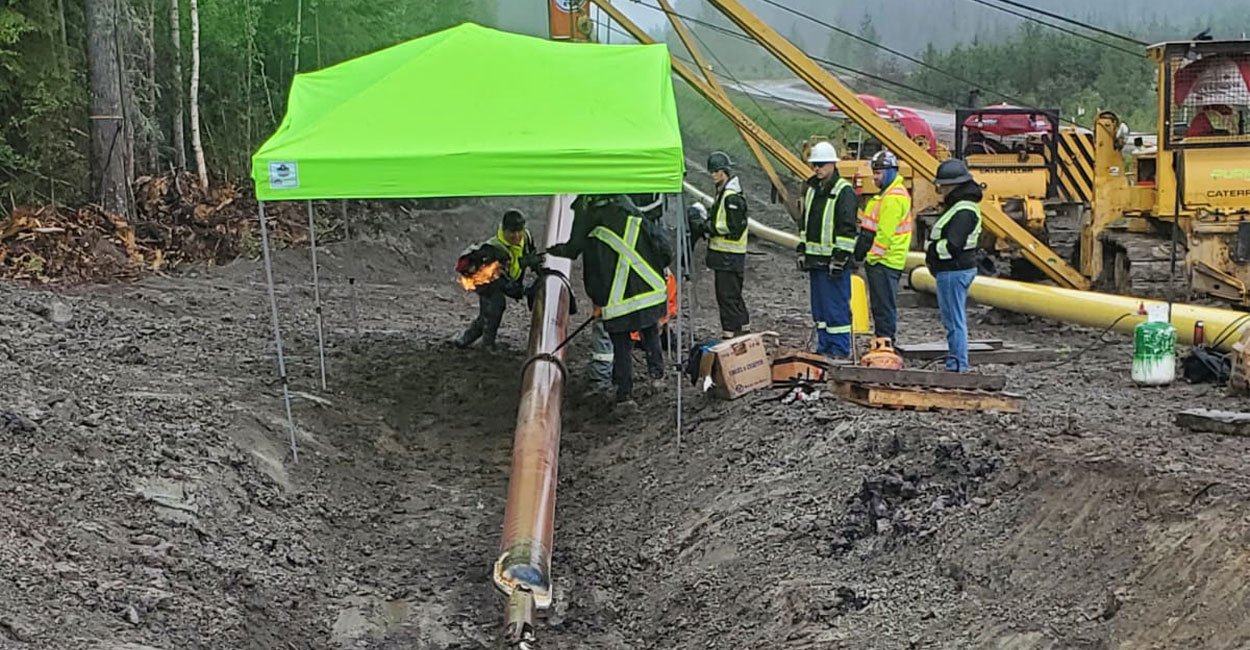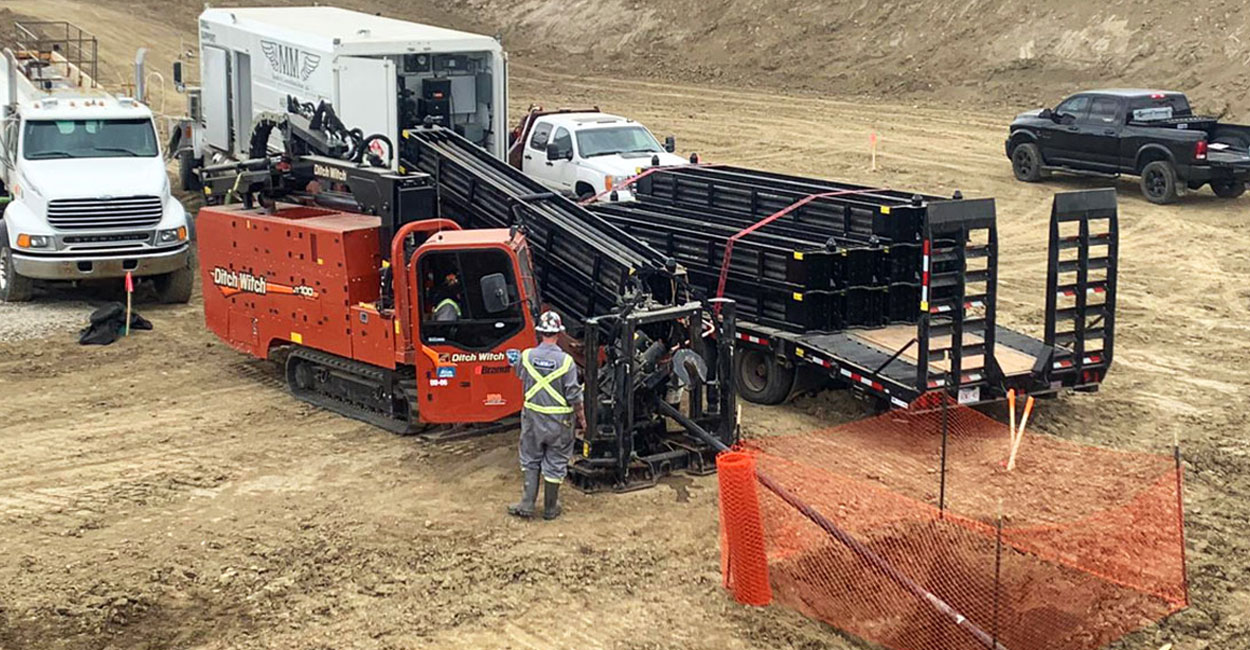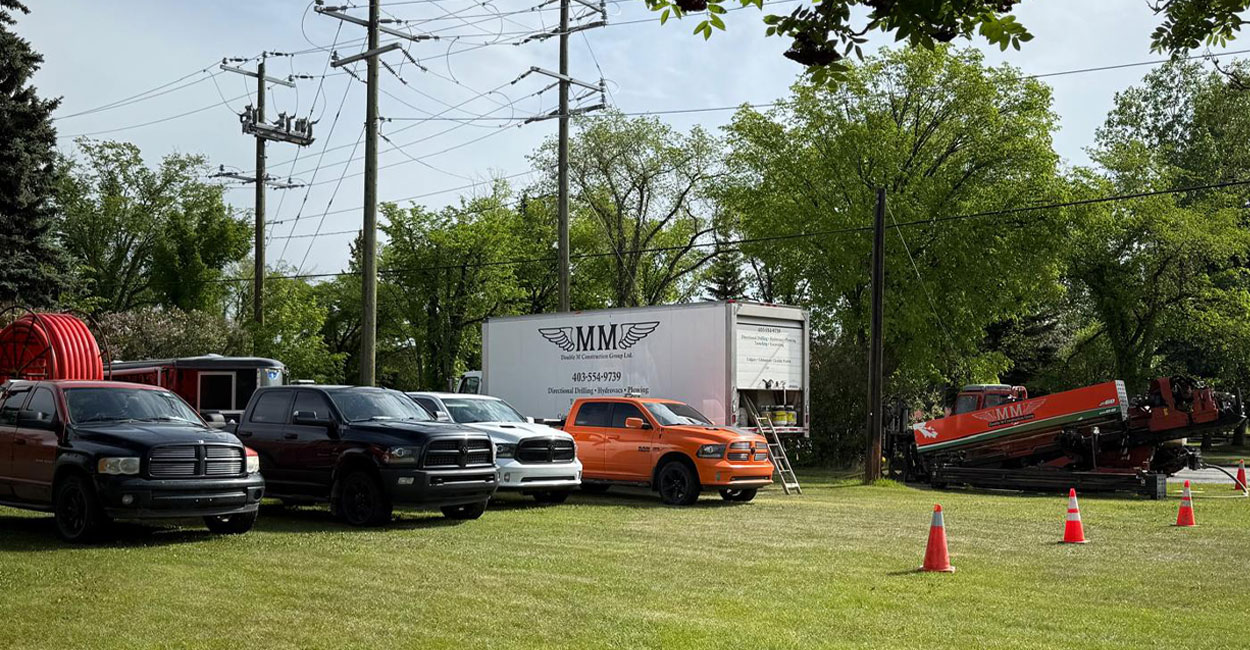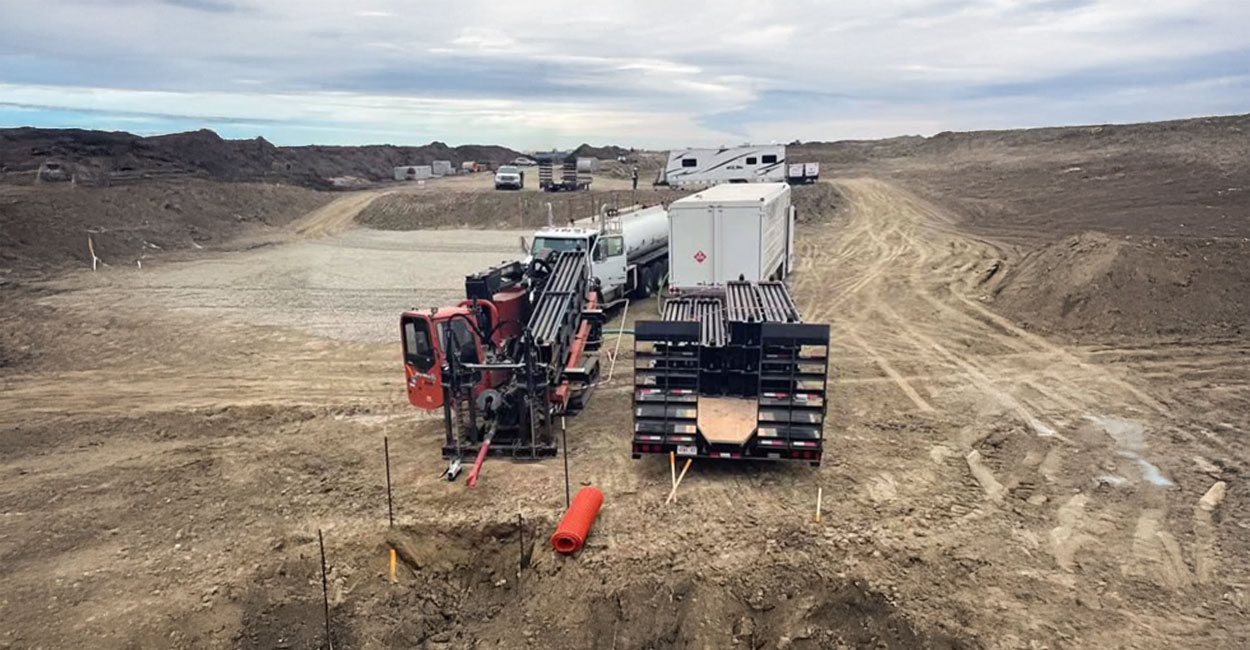Discover the ultimate guide to horizontal directional drilling (HDD) in Alberta, unlocking cost-effective, eco-friendly solutions with expert insights to help complete your projects today!
Horizontal Directional Drilling (HDD) has revolutionized the way infrastructure projects are executed across Alberta and Western Canada. This trenchless technology offers a minimally invasive alternative to traditional excavation, making it ideal for urban environments, environmentally sensitive areas, and complex underground utility installations.
Whether you’re a construction professional, municipal planner, or infrastructure developer, understanding HDD’s capabilities, benefits, and limitations is essential for successful project outcomes.
Double M Construction, with extensive experience in HDD projects throughout Alberta, provides expert insights into this innovative method. This comprehensive guide will walk you through everything you need to know about HDD—from its basic principles to advanced technology and best practices—helping you make informed decisions for your next project.
What Is Horizontal Directional Drilling (HDD)?
Horizontal Directional Drilling (HDD) is a trenchless construction technique used to install underground utilities without the need for extensive surface excavation.
Unlike traditional open-cut methods that require digging trenches along the entire length of a pipeline or cable route, HDD involves drilling a pilot hole along a predetermined path beneath the surface. This hole is then enlarged through reaming, allowing the installation of pipes, conduits, or cables with minimal disruption to the surface environment.
HDD differs from other trenchless methods like microtunneling or auger boring by offering greater flexibility in navigating around obstacles and crossing beneath roads, rivers, or railways.
Its precision and adaptability make it a preferred choice in areas where surface disruption must be minimized or where traditional excavation is impractical.

Common Applications in Construction and Infrastructure
HDD is widely used across various sectors in Alberta’s construction and infrastructure landscape.
Typical applications include installing utility lines such as telecommunications cables, water and sewer pipelines, and natural gas distribution lines.
The technology is especially valuable when crossing beneath busy roads, highways, railways, and waterways, where open-cut trenching would cause significant traffic disruptions and environmental impact.
Additionally, HDD is often employed in environmentally sensitive areas, such as wetlands or protected habitats, where minimizing ground disturbance is critical.
Its ability to navigate complex underground conditions makes it suitable for urban infill projects, industrial sites, and renewable energy infrastructure installations like wind farms and solar arrays.
When to Choose HDD Over Traditional Open-Cut Methods
Choosing HDD over open-cut excavation depends on several project-specific factors.
HDD is ideal in urban areas with congested underground utilities and limited space for surface disruption. In such environments, open-cut trenching can be costly, time-consuming, and disruptive to traffic and local businesses.
Projects that require crossing beneath environmentally sensitive zones or water bodies also benefit from HDD’s minimal surface footprint.
The method preserves existing roadways, landscaping, and natural habitats, reducing the need for extensive restoration and permitting.
Additionally, HDD is advantageous in busy infrastructure corridors, where maintaining uninterrupted service and minimizing safety risks are priorities.
However, HDD may not be the best choice for very short runs or in areas with unstable soil conditions, where traditional excavation might be more cost-effective or safer.
Understanding these nuances helps project managers select the most appropriate installation method.
Key Advantages of HDD in Alberta
Environmental and Safety Benefits
One of the most significant advantages of HDD is its reduced environmental impact.
By minimizing ground disturbance, HDD protects soil integrity, vegetation, and water quality. The use of non-toxic drilling fluids further ensures that ecosystems remain unharmed during the drilling process.
Reduced Surface Disruption
Safety is another critical benefit. HDD reduces the need for large open trenches, which can pose hazards to workers and the public in urban areas.
Smaller work zones mean fewer traffic disruptions and lower risks of accidents.
Additionally, the controlled nature of HDD operations limits exposure to underground utilities, reducing the likelihood of accidental strikes and service interruptions.
How the HDD Process Works
From Pilot Bore to Final Pullback
The HDD process begins with the pilot bore, where a small-diameter drill bit is guided along the planned underground path using advanced tracking systems.
This stage requires careful steering to avoid obstacles and maintain the correct depth and alignment.
Next is hole reaming, which involves enlarging the pilot hole to accommodate the utility pipe or conduit.
Reaming tools of increasing diameter are pulled back through the borehole, gradually widening the path.
The final stage is pipe pullback, where the utility pipe is attached to the reamer and pulled through the enlarged borehole.
Throughout this process, continuous monitoring ensures the bore path remains stable and within design parameters.

The Technology Powering HDD
Tracking and Guidance Systems
Accurate navigation is critical in HDD.
Various tracking systems are employed, including walk-over systems that use above-ground sensors to monitor the drill head’s position.
Wire-line systems provide real-time data through cables attached to the drill string, while gyroscopic systems offer precise orientation information independent of surface conditions.
These technologies enable operators to steer the drill bit around obstacles, maintain proper depth, and ensure the bore path aligns with project specifications, reducing the risk of costly errors or utility conflicts.
Equipment and Rig Capabilities
HDD rigs vary in size and power, tailored to the demands of specific soil types and project scales.
In Alberta, where soil conditions range from soft silts to rocky substrates, having a versatile fleet is essential.
Rigs with high torque and pullback force can handle longer bore lengths and larger diameter pipes, while smaller rigs offer maneuverability in confined urban sites.
Double M Construction’s equipment is selected to match Alberta’s diverse terrain, ensuring efficient drilling with minimal downtime.
This adaptability is crucial for meeting project timelines and maintaining safety standards.
Best Practices for HDD Project Success
Successful HDD projects depend on meticulous planning, skilled execution, and environmental stewardship. Implementing best practices reduces risks and enhances project outcomes.
Construction Management: Site Planning and Utility Locating
This includes conducting geotechnical surveys to understand soil composition and stability, as well as identifying existing underground utilities through advanced locating techniques.
Early and accurate utility locating prevents costly strikes and service disruptions.
Obtaining necessary permits and coordinating with local authorities ensures compliance with regulations and smooth project progression.
Effective communication among stakeholders helps address potential challenges before drilling begins.
Drilling Fluid and Waste Management
Drilling fluids play a vital role in lubricating the drill bit, stabilizing the borehole, and carrying cuttings to the surface.
Selecting the appropriate fluid mixture and managing its use responsibly minimizes environmental impact.
Recycling drilling fluids through closed-loop systems reduces waste and conserves resources.
Proper disposal of drilling waste and adherence to environmental guidelines protect surrounding ecosystems and maintain community trust.
These practices reflect a commitment to sustainable construction.
Situations Where HDD May Not Be Ideal
Despite its many advantages, HDD is not suitable for every project.
Certain soil conditions, such as cobble, boulder-strewn ground, or karst formations, can pose significant challenges due to instability and unpredictable drilling paths.
In such cases, the risk of bore collapse or deviation increases.
Additionally, HDD may be less cost-effective for very short installations where mobilizing equipment and setup costs outweigh the benefits.
Shallow depth requirements can also limit HDD feasibility, especially if existing utilities or surface structures are too close to accommodate safe drilling.
Recognizing these limitations early helps avoid project delays and cost overruns.
How to Select the Right HDD Contractor
Choosing a qualified HDD contractor is critical to project success.
Key factors to consider include the contractor’s safety record, which reflects their commitment to protecting workers and the public.
A diverse and well-maintained rig fleet ensures the contractor can handle various project demands.
Environmental policies demonstrate the contractor’s dedication to minimizing ecological impact, an important consideration in Alberta’s sensitive landscapes.
Local experience is invaluable for navigating regional regulations, soil conditions, and permitting processes.
Certification such as the Certificate of Recognition (COR) indicates adherence to industry safety standards and best practices.
Engaging a contractor who meets these criteria increases the likelihood of a smooth, efficient, and compliant HDD project.
Emerging Trends in the HDD Industry
The HDD industry continues to evolve with technological advancements and shifting market demands.
Smart rigs equipped with enhanced telemetry and automation improve drilling precision and reduce human error.
These innovations enable real-time data analysis and adaptive drilling strategies.
There is growing use of HDD in Oil and Gas projects. But, also in renewable energy projects, such as installing underground cables for wind farms and solar power facilities, reflecting the industry’s role in supporting sustainable infrastructure development.
Regulatory changes in Alberta are also shaping HDD practices, emphasizing environmental protection and safety enhancements.
Staying informed about these trends helps stakeholders leverage the latest capabilities and maintain compliance.

Frequently Asked Questions About HDD
How deep can HDD go?
HDD can achieve depths of up to 30 meters or more, depending on soil conditions and equipment capabilities. Depths are typically planned to avoid existing utilities and surface structures.
What pipe materials are used?
Common pipe materials installed via HDD include high-density polyethylene (HDPE), steel, and ductile iron. The choice depends on the utility type, pressure requirements, and environmental factors.
How long does a typical project take?
Project duration varies widely based on length, soil conditions, and complexity. Small installations may take a few days, while large-scale crossings can extend over several weeks.
Is it safe around existing infrastructure?
Yes, with proper utility locating and monitoring, HDD is designed to safely navigate around existing underground infrastructure, reducing the risk of damage.
Final Thoughts: Is HDD Right for Your Project?
Horizontal Directional Drilling offers a modern, efficient, and environmentally responsible solution for underground utility installation in Alberta.
Its ability to minimize surface disruption, enhance safety, and adapt to complex site conditions makes it an attractive option for many construction and infrastructure projects.
However, careful evaluation of site conditions, project requirements, and contractor qualifications is essential to determine if HDD is the best fit.
Engaging experienced professionals like Double M Construction ensures access to expert guidance, advanced technology, and proven best practices tailored to Alberta’s unique environment.
Contact Double M Construction Today
For a customized site assessment or project quote, reaching out to HDD specialists can provide the clarity and confidence needed to move forward successfully.
With the right approach, HDD can help deliver infrastructure projects that meet today’s demands while protecting Alberta’s landscapes for future generations.

Recommended HDD Resources for Alberta
- North American Society for Trenchless Technology (NASTT)
The leading trenchless industry organization in North America. Offers best practices, HDD training, and case studies. - Canadian Association of Pipeline and Utility Locating Contractors (CAPULC)
Relevant to utility locating and safety before HDD begins. Highly applicable in the Canadian regulatory context. - Common Ground Alliance (CGA) – Best Practices Guide
Recognized authority on safe digging and underground infrastructure protection. - Canadian Construction Association (CCA)
National industry body. Can support claims around construction best practices or trends in infrastructure. - Pipeline & Hazardous Materials Safety Administration (PHMSA – U.S. Dept. of Transportation)
While U.S.-based, PHMSA offers extensive guidelines on safe pipeline installation using HDD. - Alberta One-Call / Utility Safety Partners
Official source for safe digging in Alberta — essential in HDD prep stages.
